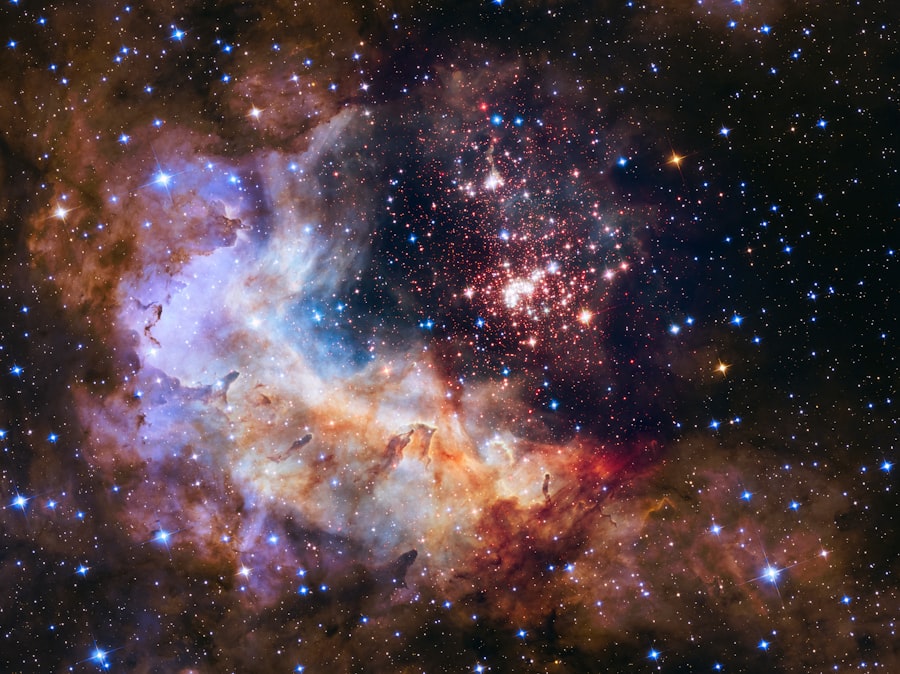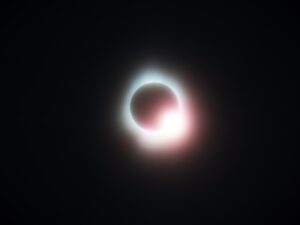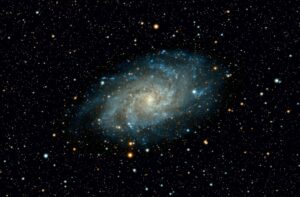Nebulae are vast clouds of gas and dust that exist in the interstellar medium, the space between stars. These celestial formations are often considered the birthplaces of stars, as they contain the raw materials necessary for stellar formation. Composed primarily of hydrogen, helium, and trace amounts of heavier elements, nebulae can vary significantly in size and density.
Some nebulae are so large that they can span several light-years across, while others may be more compact and dense, creating regions where new stars are born. The term “nebula” originates from the Latin word for “cloud,” which aptly describes their appearance when viewed through telescopes. They can be seen in various forms, including bright, glowing clouds illuminated by nearby stars or dark silhouettes against the backdrop of more distant stars.
The study of nebulae is crucial for understanding the lifecycle of stars and the chemical evolution of galaxies, as they serve as both the cradle and grave for stellar bodies. Their intricate structures and dynamic processes make them a focal point of astronomical research.
Key Takeaways
- Nebulae are vast clouds of gas and dust in space, often illuminated by nearby stars.
- Nebulae form from the remnants of dying stars, as well as from the gravitational collapse of gas and dust.
- There are several types of nebulae, including emission, reflection, and dark nebulae, each with unique characteristics.
- Nebulae play a crucial role in the universe by serving as the birthplace of new stars and planetary systems.
- Nebulae can be observed from Earth using telescopes and other astronomical instruments, providing valuable insights into the cosmos.
The Formation of Nebulae
Nebulae typically form from the remnants of dying stars or from the gravitational collapse of gas and dust in the interstellar medium. When a massive star exhausts its nuclear fuel, it undergoes a supernova explosion, dispersing its outer layers into space. This ejected material can coalesce with surrounding gas and dust to form a new nebula.
In contrast, smaller stars may shed their outer layers more gently, creating planetary nebulae that also contribute to the formation of new nebular structures. The process of nebula formation is often initiated by shock waves from nearby supernovae or other energetic events that compress regions of gas and dust. This compression can trigger gravitational instabilities, leading to the collapse of these regions under their own gravity.
Over time, these protostars will continue to gather mass and may ignite nuclear fusion, marking the birth of a new star. The surrounding nebula will then evolve, with some material being expelled back into space while other parts may continue to condense into additional stars or even planets.
Types of Nebulae

Nebulae can be classified into several distinct categories based on their characteristics and formation processes. The most commonly recognized types include emission nebulae, reflection nebulae, dark nebulae, and planetary nebulae. Emission nebulae are regions where gas is ionized by the intense radiation from nearby hot stars, causing them to glow brightly.
A prime example is the Orion Nebula, which is one of the most studied regions of star formation in our galaxy. Reflection nebulae, on the other hand, do not emit their own light but instead reflect the light from nearby stars. These nebulae often appear blue due to the scattering of shorter wavelengths of light by dust particles.
The Pleiades star cluster contains several reflection nebulae that beautifully illustrate this phenomenon. Dark nebulae are dense clouds of gas and dust that block light from objects behind them, creating stark contrasts against the backdrop of brighter stars and nebulae. The Horsehead Nebula is a well-known example of a dark nebula that captures the imagination with its distinctive shape.
Planetary nebulae represent a later stage in the life cycle of medium-sized stars. When these stars exhaust their nuclear fuel, they expel their outer layers into space, forming a shell of ionized gas around a hot core. The Ring Nebula is a classic example of a planetary nebula, showcasing a stunning ring-like structure that results from this process.
Each type of nebula plays a unique role in the cosmic ecosystem, contributing to the ongoing cycle of stellar birth and death.
The Role of Nebulae in the Universe
| Nebula Type | Composition | Role in the Universe |
|---|---|---|
| Reflection Nebulae | Dust and gas | Reflect and scatter light from nearby stars |
| Emission Nebulae | Ionized gases | Produce light by emitting their own radiation |
| Dark Nebulae | Dense dust clouds | Obscure the light from objects behind them |
| Planetary Nebulae | Expelled outer layers of dying stars | Enrich the interstellar medium with heavy elements |
Nebulae play a pivotal role in the universe’s ecosystem by acting as both nurseries for new stars and repositories for stellar remnants. They are essential for understanding how galaxies evolve over time, as they provide insights into the processes that govern star formation and chemical enrichment. As stars form within these clouds, they produce heavier elements through nuclear fusion, which are then released back into the interstellar medium when these stars die.
This recycling process enriches the surrounding gas and dust with elements necessary for forming planets and life as we know it. Moreover, nebulae contribute to the overall structure and dynamics of galaxies. The gravitational interactions between different regions within a nebula can lead to the formation of clusters of stars or even entire star systems.
These interactions can also influence the motion of gas and dust within galaxies, affecting star formation rates and galactic evolution. In this way, nebulae serve as both catalysts for new stellar generations and as markers of a galaxy’s history.
Observing Nebulae from Earth
Observing nebulae from Earth presents both challenges and opportunities for astronomers. While some nebulae are visible to the naked eye under dark skies—such as the Orion Nebula—most require telescopes equipped with specialized filters to capture their intricate details. Modern telescopes can utilize various wavelengths of light, including infrared and radio waves, to penetrate dust clouds and reveal hidden structures within these cosmic formations.
The advent of space-based observatories like the Hubble Space Telescope has revolutionized our ability to study nebulae in unprecedented detail. Hubble’s high-resolution images have unveiled stunning colors and intricate structures within nebulae that were previously obscured by Earth’s atmosphere. For instance, Hubble’s observations of the Carina Nebula have provided insights into massive star formation processes occurring within this region.
Additionally, ground-based observatories equipped with adaptive optics technology can also enhance our ability to observe these distant objects by compensating for atmospheric distortions.
Unraveling the Mysteries of Nebulae

The study of nebulae continues to be a rich field for astronomical research, as scientists seek to unravel their many mysteries.
Researchers employ computer simulations alongside observational data to model how gravitational instabilities lead to star birth in various types of nebulae.
These models help explain why some regions are more conducive to star formation than others and how environmental factors influence these processes. Another intriguing aspect is the chemical composition of nebulae. By analyzing the light emitted or absorbed by different elements within a nebula, astronomers can determine its chemical makeup and track how it evolves over time.
This information is crucial for understanding not only stellar evolution but also the origins of elements in our universe. For example, studies have shown that certain types of supernova remnants enrich surrounding nebulae with heavy elements like carbon and oxygen, which are essential for life on Earth.
The Future of Nebula Exploration
As technology advances, so too does our ability to explore and understand nebulae more deeply than ever before. Upcoming missions such as NASA’s James Webb Space Telescope promise to provide unprecedented views of these celestial phenomena in infrared wavelengths. Webb’s capabilities will allow astronomers to peer through dust clouds and observe star formation processes in real-time, offering insights into how stars like our Sun came into existence.
In addition to space-based observatories, ground-based telescopes are also evolving with new technologies that enhance their observational capabilities. Projects like the Extremely Large Telescope (ELT) aim to provide detailed imaging and spectroscopy of distant nebulae, enabling scientists to study their physical properties and dynamics with greater precision. These advancements will not only deepen our understanding of individual nebulae but also contribute to broader questions about galaxy formation and evolution across cosmic time.
The Beauty of Nebulae
Beyond their scientific significance, nebulae captivate observers with their breathtaking beauty. The vibrant colors and intricate shapes found in images captured by telescopes evoke a sense of wonder about the universe’s vastness and complexity. Each nebula tells a story—a narrative woven from gas and dust that spans millions of years.
The visual splendor of nebulae has inspired artists, poets, and dreamers throughout history. From ancient civilizations that gazed at the night sky to modern astrophotographers who capture stunning images using advanced technology, nebulae continue to ignite our imagination. Their ethereal forms remind us not only of our place in the cosmos but also of the ongoing journey to understand the universe’s mysteries—a journey that is as beautiful as it is profound.
In exploring the vast universe of philosophical concepts, Nebula serves as a fascinating backdrop for understanding the intricacies of existence and essence. A related article that delves into these themes is Sartre’s concept of existence preceding essence, which challenges traditional philosophical ideas and embraces individual freedom. You can read more about it in this insightful piece: Sartre’s Concept of Existence Preceding Essence.





















+ There are no comments
Add yours